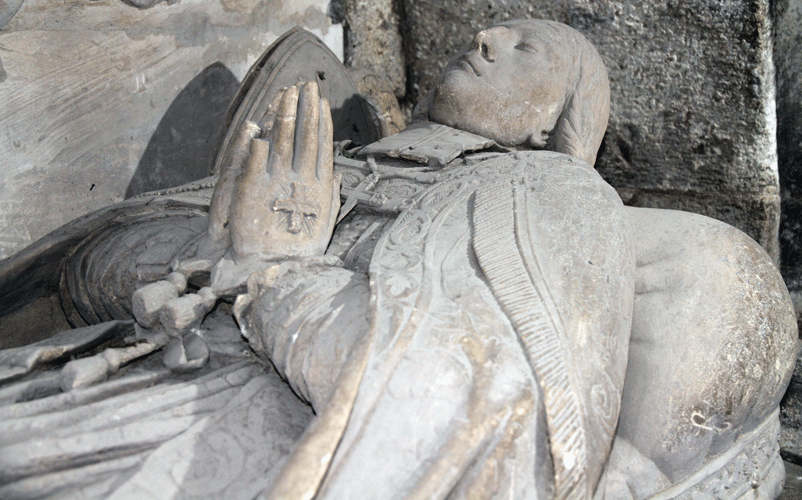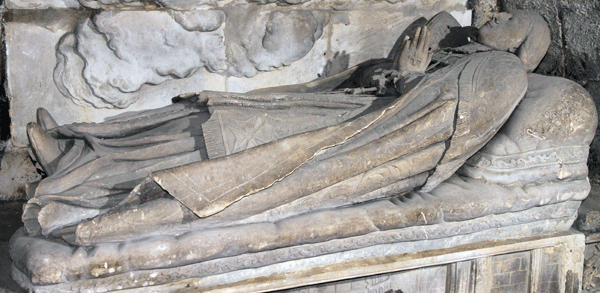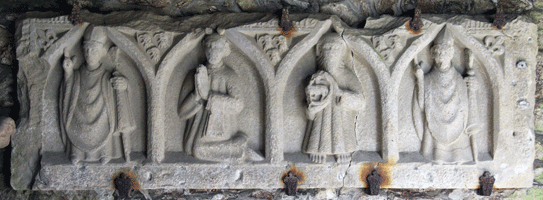|
|
|
Commune
|
| Créhen
Dinan
Léhon
Plumieux St
Brieuc Tréguier |
| |
 |
This effigy is set in the floor at the end
of the south transept behind the seating. It is difficult
to find, let alone see and photograph. It appears to be a
military effigy in low relief and now very worn. The list gives
the date as 17th century but no reference. The low relief would
suggest an early date but there are a number of these low relief
effigies in Brittany of the 14th and 15th century, alongside
those in the round. I have never discovered a cross legged
effigy in France but perhaps the curious leg position is as near
as we get! |
|
|
DINAN |
| Park in one of the several modestly priced
car parks |
| In the Town |
 |
 |
| This unknown knight is in a
pedestrian street although mainly protected from the weather. |
| Chȃteau
- Museum (No Longer Applicable) |
Check on the
website for current opening
times which vary, as will the entrance fees. The
museum is in the chȃteau; turn
left after going through the main gate or ask the attendant
to direct you to the gisants. These are in a
basement and there are signposts once you reach the correct
building, which is not the main keep. Be prepared to
negotiate a steep stone spiral staircase. The floor of
the basement is very uneven and can be partly flooded, so
wear the correct shoes and be prepared to get you feet wet!
However this is a fine collection so the journey is well
worth it.
Note: these monuments are no longer in the château
museum: they were moved because of their deterioration
caused by the poor environment in the cellar. See below |
 |

Said to be
Renée Madeuc de Quemadeuc, 2nd wife of
Geoffroy le Voyer
14th century
|
 |
 |
 |

Rolland de Dinan (?-1186)
Abbey of
Beaulieu, arrived here in 1848. Arms are: gules
lozengy argent. Mid 13th century |
 |
 |

Berthelot d'Ensoulevent,
Lieutenant of Robert de Buitte
Late
14th century
|
 |

Above and right:
Guillaume de Lesquen, Abbot of Beaulieu late 14th
century
Below and left: :
Geoffroy le Voyer (d.
between 1346-1365),
Baron of
Trevenar, Chamberlain to Duke John III of Brittany.
Priory of Saint-Georges de Trémeur;
transferred to St Malo church in 1923, then to here in
1981. Identifying arms: argent three battle axes sable.
 |
 |
 |
 |

Unknown Knight & Lady: Low Relief |
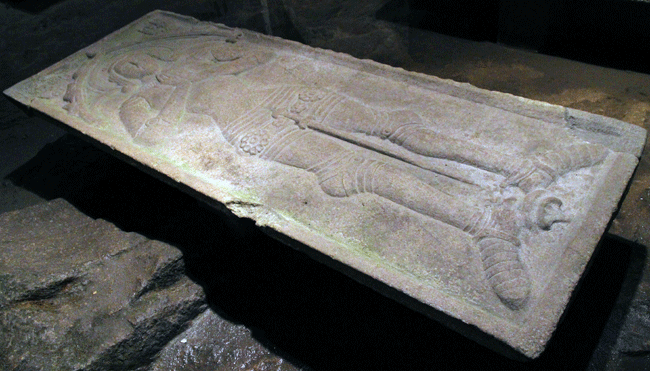
Unknown knight.
Very Low Relief
Church of the Jacobins, Dinan |
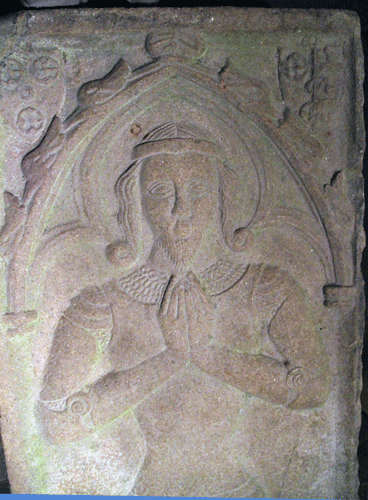 |
|
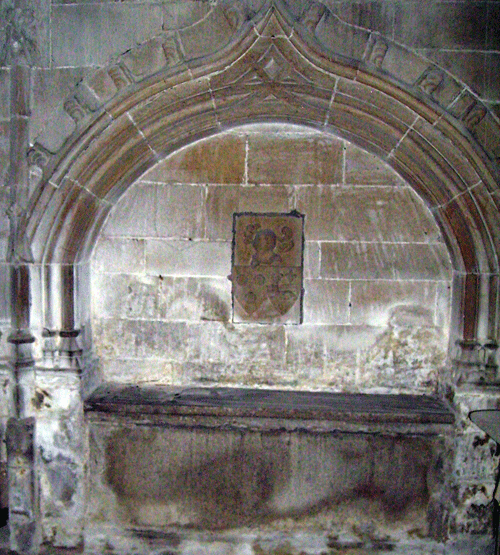
Above and right top:
Effigy in low relief |
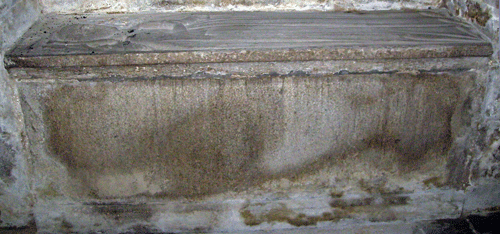
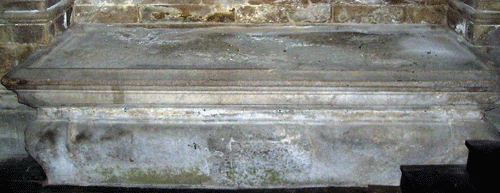 |
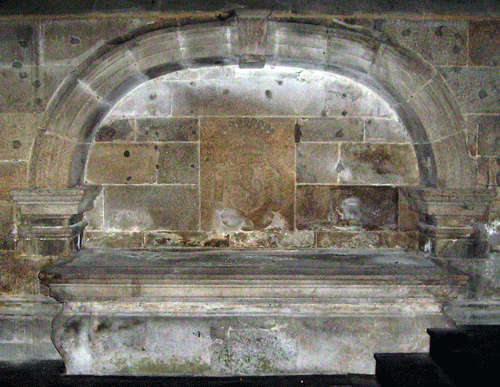
Above and left bottom: Similar but the effigy has
been totally obliterated |
 |
 |
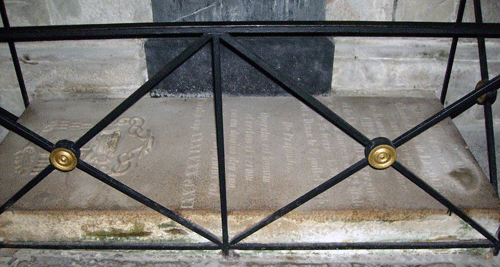
Above top: Floor slab not yet
identified; the slab to Monsignor Claude-Louis
de Lesquen covers its left side somewhat.
Above bottom and right: Slab and monument to Monsignor Claude-Louis
de Lesquen Bishop of Beauvais and Rennes
(1855) |
 |
Basilica of St
Sauveur |
|
| |
| Déjà
Vu? |

Rolland de Dinan
|
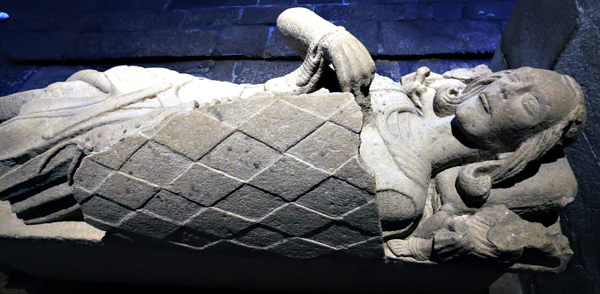 |
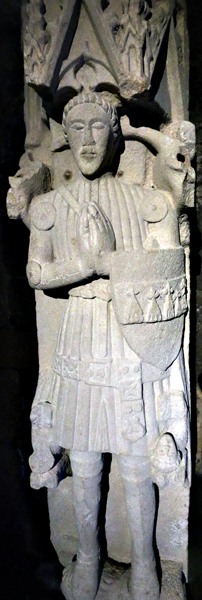 |
 |
|
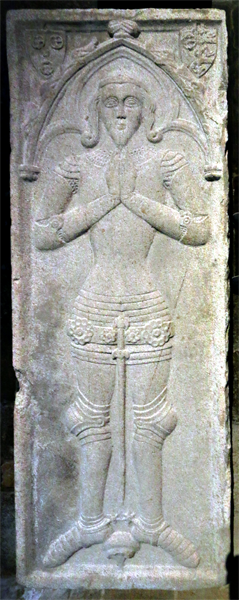 |

Above:
Berthelot d'Angoulevent
Right: Gaillaume de Lequen |
|
|
| If you think you've seen these effigies
before, you will be right if you have scrolled down the page
from the top. I noticed a part of an effigy on a photograph of
the heart burial monument of Bertrand de Guesclin and decided to
have a look to see what was there when we next visited Dinan;
the original plan for the visit was to see the heart burial
monument in Autumn 2021. There were three related monuments
which I thought was in the styles of those in the Château
museum, in the partly flooded cellar. 'In the style of' was
incorrect': they were from the Château museum, having been moved
between the time we visited there and out visit to this
basilica. The remaining monument are now in the church of St
Malo |
 |
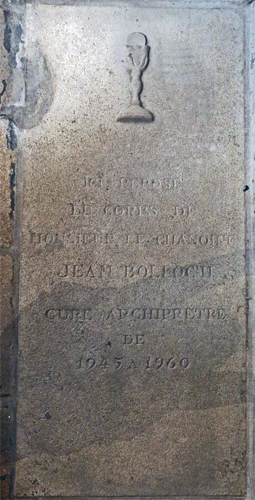 |
| A modern grave slab has been inserted into a
medieval tomb arch. This inscription is to: Monsigneur
Canon Jean Bolloch, pastor archpriest |
| The Heart Burial Monument of
Bertrand du Guesclin |

Bertrand de Guesclin (c.
1320-1380) was a
leading French military
commander during the
early part of the Hundred Years' War,
who was appointed Constable of France (Head of the Army) by King
Charles V, a post normally held by a nobleman.
He died of dysentry or hyperthermia following the seige
of Châteauneuf-de-Randon, Lozère (former
region, Languedoc-Roussillon) on 4th July 1380 after the
English, who had held the town surrendered.Before
his death he had dictated his will stating that he wished to be
buried in his native Brittany, in the Church of the Jacobins at
Dinan, where his ancestors were interred.
Languedoc-Roussillon) on 4th July 1380 after the
English, who had held the town surrendered.Before
his death he had dictated his will stating that he wished to be
buried in his native Brittany, in the Church of the Jacobins at
Dinan, where his ancestors were interred.
Dinan is a long journey from
Châteauneuf-de-Randon - a distance of a little over 500 miles -
so it was essential, especially in the summer heat, to embalm
the Constable's body. This was carried out at the Convent of the
Jacobin, Le-Puy-en-Velay, Haut-Loire (Auvergn) were the
viscera, including the brain, were removed, from the body.
These organs were buried at the church of the Convent, St
Laurent, where there was a funeral service on the 23rd July. A
monument was constructed over the burial site, which may be seen
today.
However, Olivier de Mauny, the former
close companion of du Guesclin, with the funeral procession had
already left Put-en-Velay, for, on the 18th July they arrived at
Clermont-Ferrand, where it was found that the Constable's body
was beginning to decay despite the embalming. It was therefore
decided to separate the soft tissues (the 'flesh') from the bony
skeleton, so, at the Dominican Convent of Montferrand (a suburb
of the city), the body was boiled in a cauldron to effect this
process. The soft tissues were buried there with a second
funeral service and then the procession continued on its way but
now only carrying the Constable's bones and heart . It is not known
if a monument were constructed over the
site of the burial of the soft tissues at Montferrand as there
appears appears to be no drawing or other record of such a
construction, although it is likely. Constable's body
was beginning to decay despite the embalming. It was therefore
decided to separate the soft tissues (the 'flesh') from the bony
skeleton, so, at the Dominican Convent of Montferrand (a suburb
of the city), the body was boiled in a cauldron to effect this
process. The soft tissues were buried there with a second
funeral service and then the procession continued on its way but
now only carrying the Constable's bones and heart . It is not known
if a monument were constructed over the
site of the burial of the soft tissues at Montferrand as there
appears appears to be no drawing or other record of such a
construction, although it is likely.
The procession crossed the Loire at Angers and then
letters arrived from the King requesting that du Guesclin's body
be buried in the Basilica of St Denis at the foot of the tomb that
King Charles had prepared for himself in the chapel of St John the
Baptist, a rare honour. The King was to die two months after the
Constable. The route to Brittany was abandoned and the
procession headed towards the town of St Denis and its basilica, now a suburb of Paris.
These monuments may be seen today.
The casket containing the Constable's heart continued on
its journey to Dinan where it was buried, in the Church of the
Jacobins, beneath a slab of
granite painted black with an incised inscription in gold
lettering. Below the inscription was the arms of the Du Guesclin
family, below this a heart, and then below this the arms of
Bertrand himself (top right),
who belonged to a cadet branch of the Du Guesclin family. So
only the heart of the Constable came to rest where he had wished
his body to lie.
In 1890 the heart in its casket and the slab were
transferred to the Church of St Saviour, also at Dinan. See
photograph above left.
The inscription reads:
Here lies the heart of M. Bertrand Guaquin, in his
lifetime Constable of France,
Who died the 13th day of July in the year 1380.
Whose body lies with those of the Kings in St Denis,
France. |
The inscribed slab dates from the 14th century, that is
from the time of du Guesclin, but the vertical structure in
which it is now set only from the 18th; the actual casket
probably also dates from that latter time
More information may be found
here
|
 |
 |
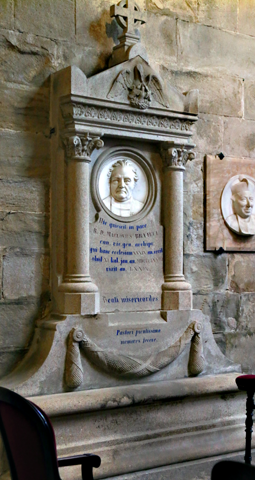 |
Top left:
Unnamed. Top centre: Jacques Daniel (1909)
Canon, archpriest, vicar-general.
Right: Maclomis Braaem (?) (1873)
Canon, vicar-general |
|
 |
Léhon
- Abbaye Saint-Magloire de Léhon |
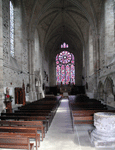 |
Léhon
is very close to Dinan and well worth a visit. There is a charge for entry to the museum,
which is housed in the original monastic buildings, but not the
church; there is no charge for photography. Free parking
around the church. Excellent restaurant in the commune.
The abbey is open in July and August every morning -
except Sunday - 10.30 to 12.30; and every afternoon
14.30 to 18.30. There are guided tours all year for
groups and students. It is advised to check website
here.
The identification of these monuments is somewhat
speculative: there are several coats of arms and one
inscription |
 |
| Jean IV de Beaumanoir
(1367) Lord of
Beaumanoir and La Hardouinaye. Marshal of Brittany |
 |
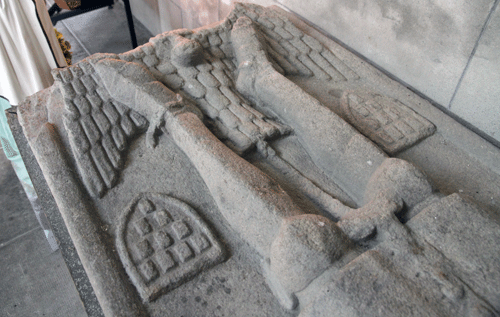 |
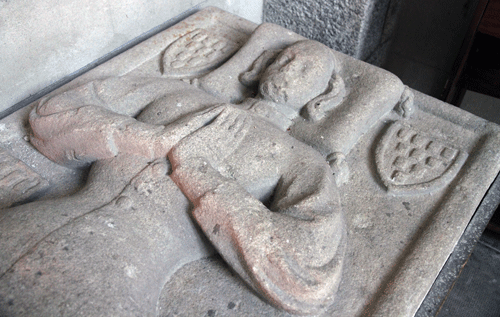 |
| Jehan III
Beaumanoir (1366) Hero of Trente. Lord of
Beaumanoir and La Hardouinaye. Stone |

Jean V de Beaumanoir
(1385) Lord of
Beaumanoir and La Hardouinaye Assassinated by
Rolland Moysan & Geoffroi Robin at the instigation
of Pierre de Tourneune. Granite |
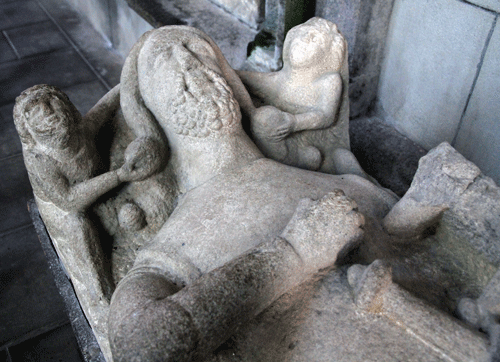 |

Gervaise
de Dinan (1239)
wife of Jehel III de Mayenne,
Geoffroy de Rohan and Richard le Maréchal.
Stone |
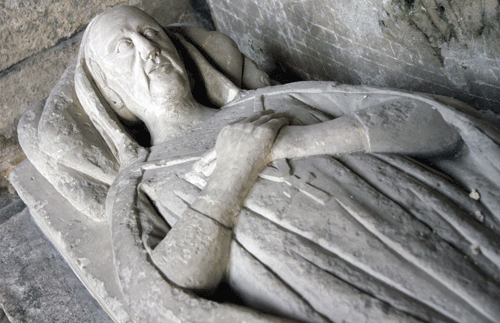 |

Marguerite
d'Avaugour (1240)
wife of Henri II
d'Avaugour and mother of Alain II d'Avaugour.
Limestone |
 |

Raoullin
Pollo (1416) father of a prior of Léhon
accoring to the inscription Granite. |
 |

Prior of Lehon
14th century Granite. Low relief except for
the head which has been cemented into place. Is the latter a
replacement? |
 |

Robert IV de
Beaumanoir (1408) Lord of
Beaumanoir and La Hardouinaye. Granite |
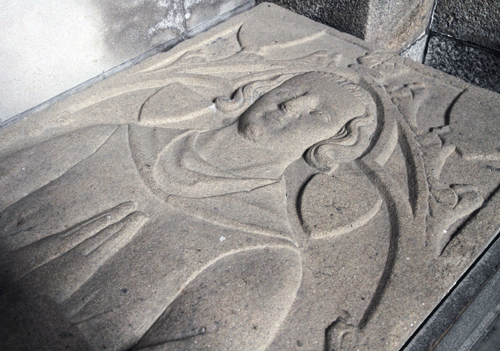 |
|
 |
Plumieux - Église St
Pierre |
| The is plenty of free parking around the
church and a car park with toilets behind the church itself (the
north side). The main (south)entrance fronting onto the
street is locked but the north door (in the car park) is
unlocked. Dark interior. |
 |
The List records there is a recumbent effigy
of a XV century lady on a tomb chest, with arms and of granite.
There was no such monuments in St Peter's Church at Plumieux but
rather this poorly preserved incised slab with an inscription.
Either there is another Plumieux with a church dedicated to St
Peter or the list is incorrect. |
| |
|
|
Saint-Brieuc -
Cathédrale Saint-Etienne |
 |
These photographs
were taken several years ago and 'lost' somewhere on the
computer system; they have only just been found. I no longer
have the notes so some I cannot now identify many.
The large majority are ecclesiastical monuments. |
 |
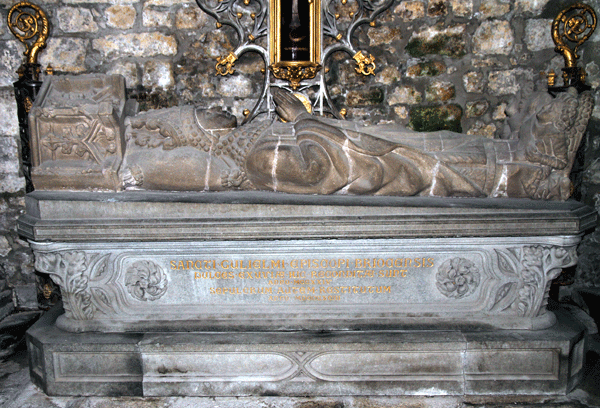
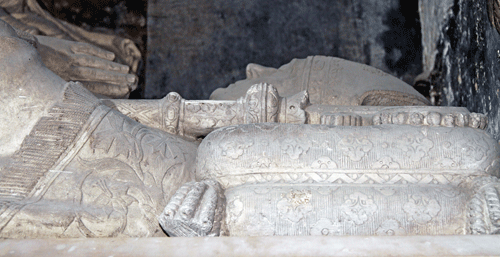 |
 |
Above: Bishop Mgr Le Mee (1858)
Right Top: Cenotaph of Saint William Pinchon
(1234) He was buried in the Chapel of the Annunciation
where the cenotaph was constructed in 1956. Note the reliquary
attached to the wall behind the monument which contains a long
bone of the Saint. |
Above and left bottom:
Bishop Mgr Martial (1861) |
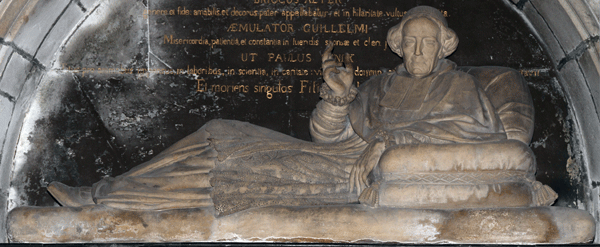 |
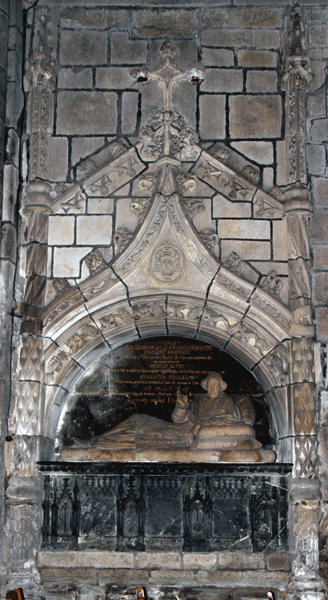 |
 |
 |
Above and right: Bishop Mgr
Le Groing de la Romagère (1841)
Next tight and far right: Bishop Mgr
David (1882)
|
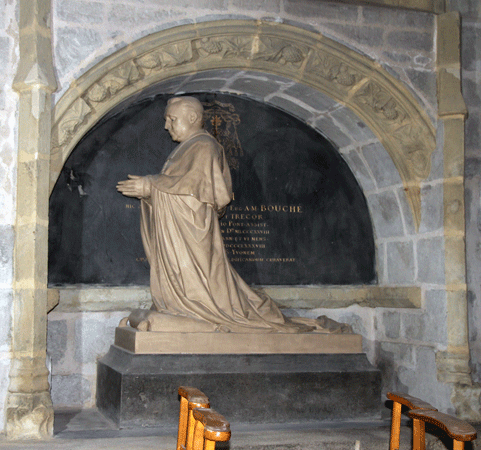 |
 |
| Bishop Mgr Bouché (1888)
|
|
Floor Slabs |
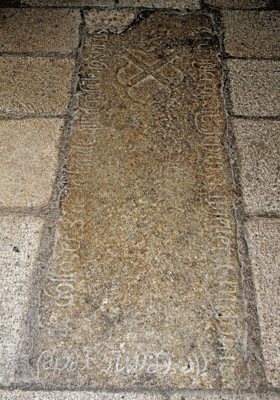 |
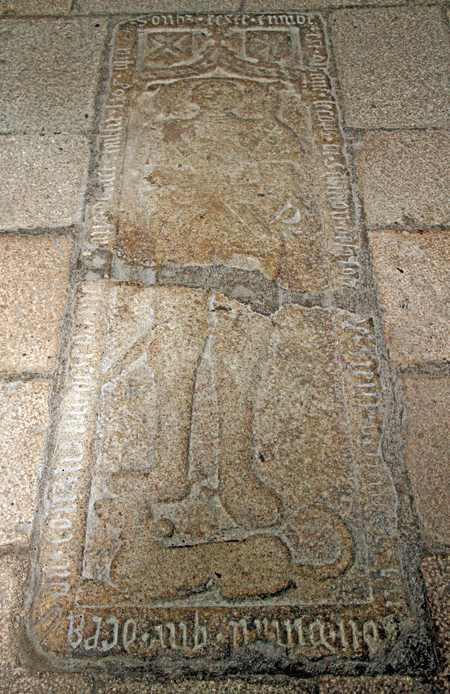 |
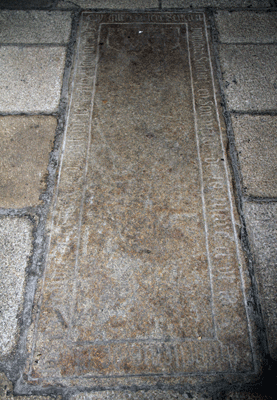 |
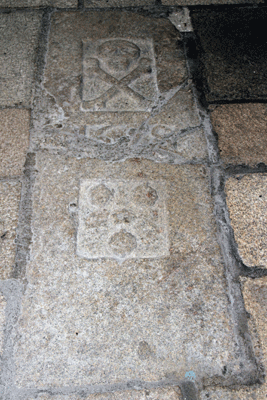 |
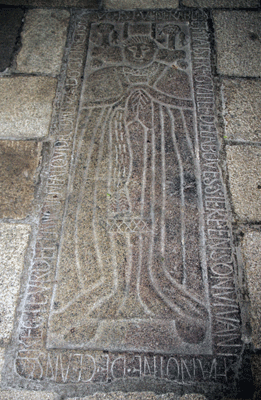 |
|
Incised inscription, arms low relief |
Knight, low relief,
inscription & heraldry |
Incised slab, arms and inscription only |
Unidentified, low relief, no inscription |
Incised, ecclesiastic, inscription |
| There are a
number of floor slabs, mainly incised slabs but some in very low
relief, or partly so. Several examples are shown above but, to
avoid tedium, the others, not classified may be seen
here. |
|
Tomb Niches |
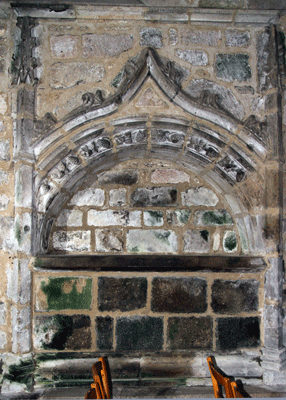 |
 |
 |
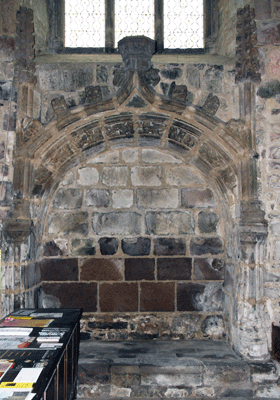 |
| |
Bishop Mgr Pierre Jean Marie Kervennic
(1991) |
|
|
| Some of these appear to have
been reused after the destruction of the original tomb chests
etc |
 |
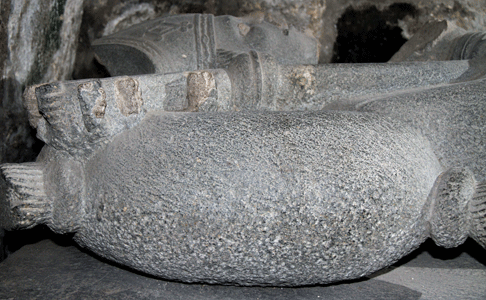 |
 |
 |
| Bishop Mgr Andreas Le Porc de la
Porte (1632) |
There still remains a worn incised slab of a
bishop in this niche |
Bishop Louis Frétat de Boissieux
(1720) |
|
|
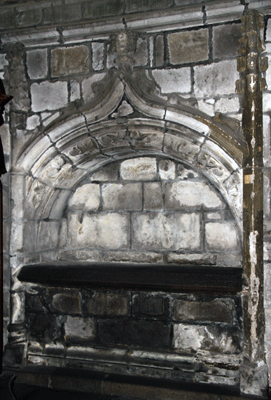 |
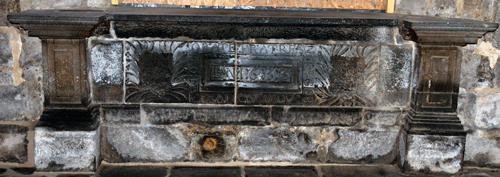 |
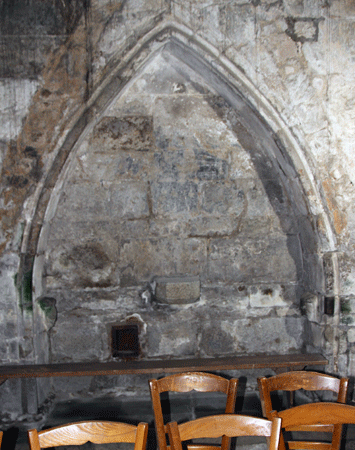 |
| |
Above: Brother
Francis (1633) |
|
| Plénée-Jugon -
St Pierre |
After our visits to the delightful towns of Ploërmel
and Josselin, this was rather a depressing place to visit. There
are reported two monuments in the church:
1. Armaury de la Moussaye (c. 1515) Coat of arms.
Granite. First quarter of 16th century
2. A lady of de Moussaye. Granite. 15th - 16th centuries
The church was easy to find and there were a number of free parking
places outside. However, although the church had about six
doors, all were locked. Toilets nearby. Second visit produced
the same effect and the nearby marie, who may have held
a key, was closed that day. |
|
| |
Tréguier
Cathedral
Tréguier is
no longer the seat of a bishop, the bishopric having been
abolished in 1801 when it was divided between the
diocese of Quimper and Saint-Brieuc. Although it is
strictly no longer a cathedral, the church is still
refered to as Tréguier Cathedral.
|
|
|
There are a number of
effigies and slabs in the cathedral, both in the body of
church and in the cloisters. There is no entrance fee and no charge
for photography. As far as I can tell you may park in
the square outside the cathedral at no charge. |
|

Unknown Bishop |
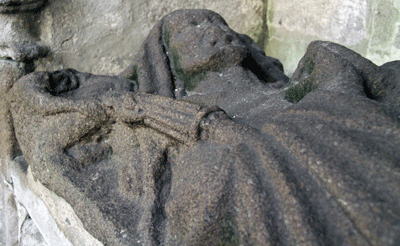 |

Unknown Knight |
 |

Unknown Knight |
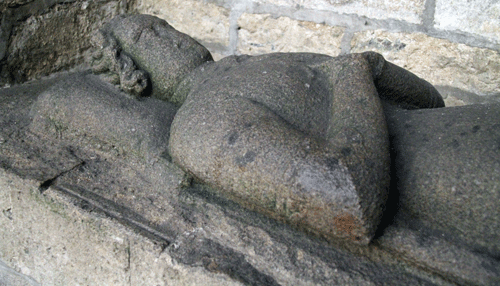 |

Jean de Lantillac (1461)
Canon of Tréguier;
Archdeacon of Plougustel |
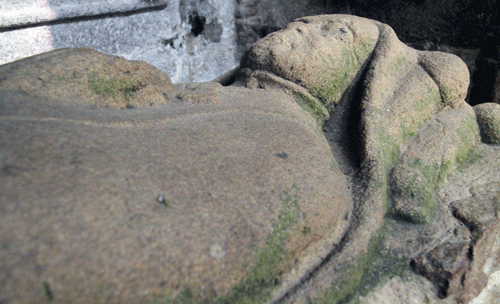 |

John, Duke of
Brittany (1389-1442)
The monument was
constructed towards the end of the 19th century. |
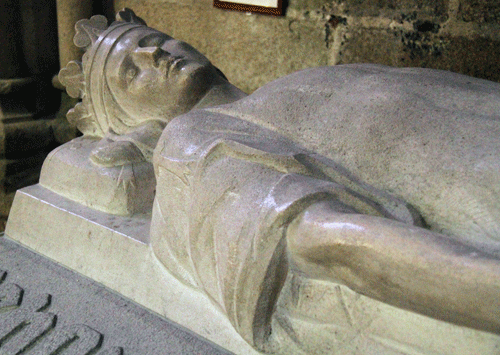 |
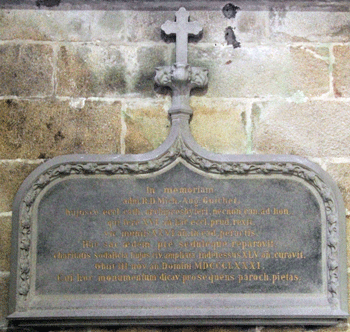
|
 |
 |
 |
Monument and effigy of
St Yves Hélory
de Kermatin (c. 1250-1340), priest of the
diocese of Tréguier. The monument was constructed
towards the end of the 19th century. His skull and parts
of two long bones are preserved in a nearby glass case.
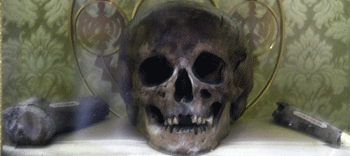 |
| The
Cloisters |
| These effigies, slabs, tablets and fragments (many of which may
be from monuments) are generally in a poor and weather worn
condition. Beaulieu Abbey was near the town of Dinan.
The cathedral of Saint-Bieuc is in the area as are the communes
of Yffinian and Lannebert. I have not yet located the Priory of
St Pierre Marigon |
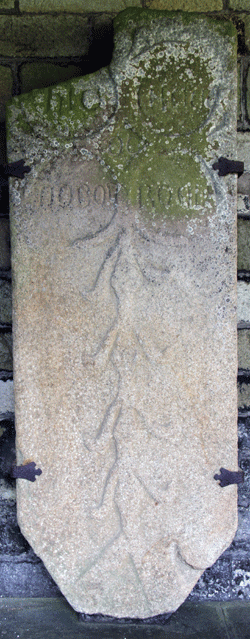
|

|

Guy de Lyonanais
Abbot of Beaulieu, then Canon de Renne
Beaulieu
16th C
|
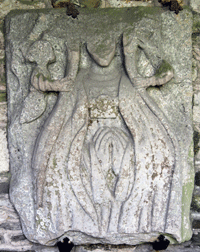
|
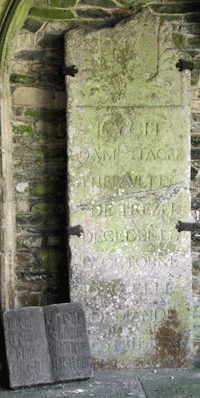
|
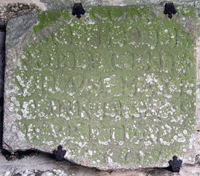
|

|
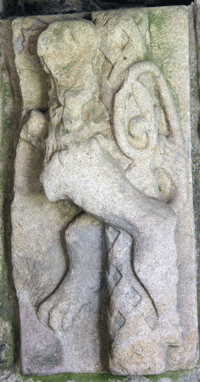
|
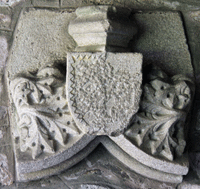 |
|
 |
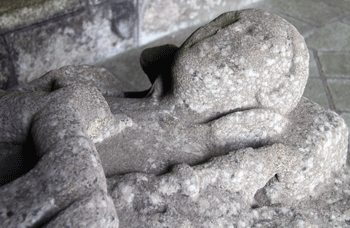
Unknown Abbot 14th
Century. Abbey of Beaulieu |
 |

Guillaume
Boutier, Abbot of Beaulieu 1426-1468.
Abbey
of Beaulieu |
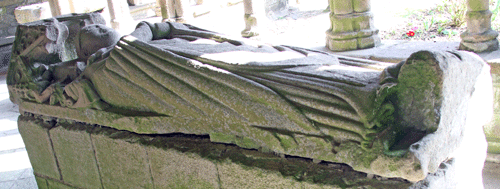 |
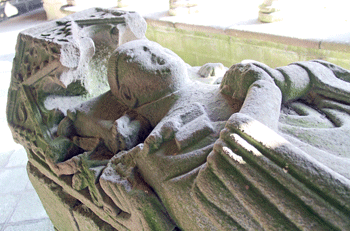
Guillaume
le Floche, Abbot of Beaulieu 1406-1426
Abbey of Beaulieu |
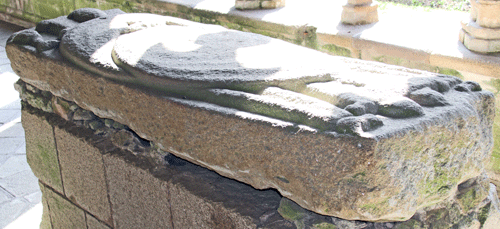 |
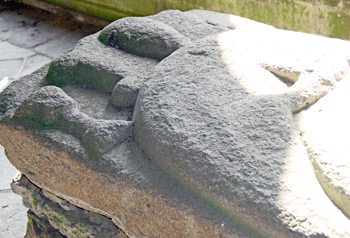
? Prêtre,
Priory of Saint
Pierre Marigon (14 C) |
 |
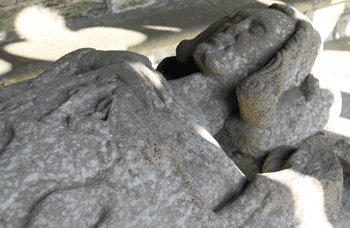
Pierre de
Chabucet, Canomide St Brieuc
Cathedral of St Brieuc (15th C) |
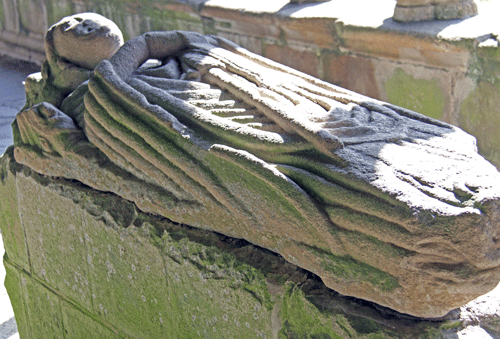 |

Alaine de
Vitré (fl 1197)
Signeur pf Vitré,
Seneschal of Brittany. Abbey of Beaulieu
13th Century
|
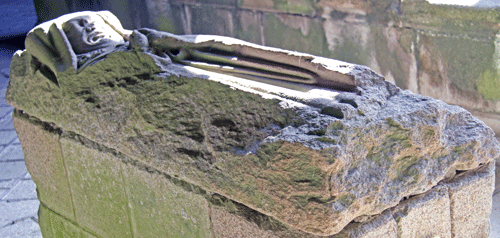 |
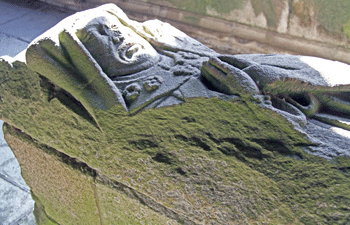
Guy Edet
, Bishop of St Brieuc 1428-1431. Cathedral
of St Brieuc |
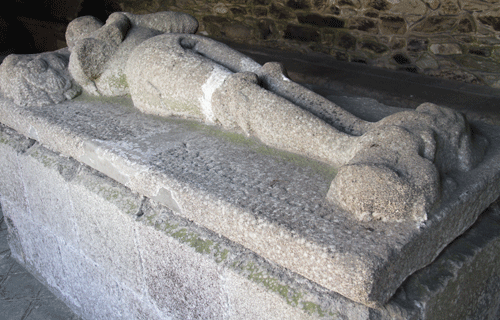 |
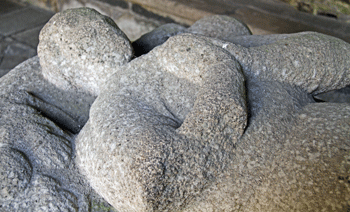
Eon
Gillebert, Knight Yffiniac Church, 14th
Century |
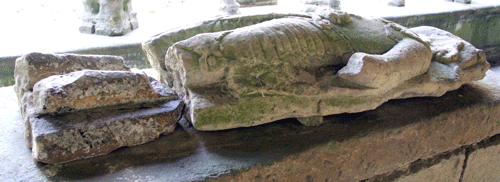
A knight of the
Boumê
family.
Lannebert Church 16th
Century
|
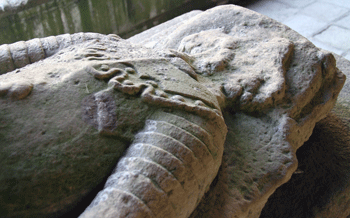 |
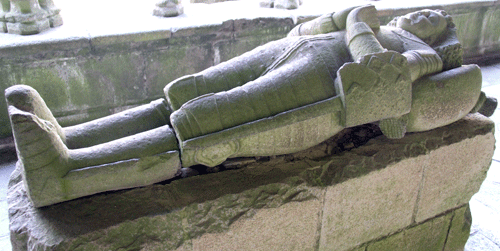 |

A knight of the
Bréhaut
family.
St Michael's Church,
St Brieuc 16th century |
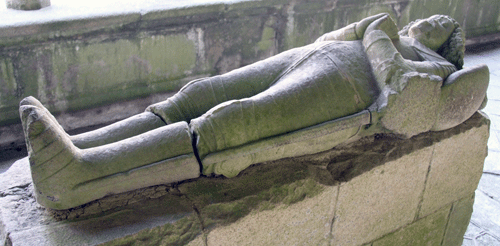 |
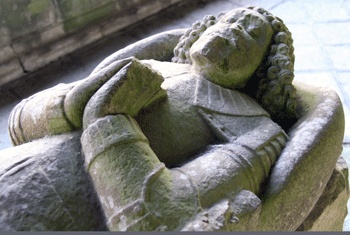
A knight of the
Bréhaut
family.
St Michael's Church,
St Brieuc 16th century |
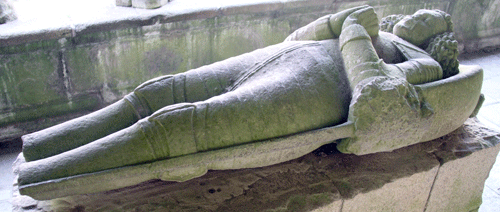
A knight of the
Bois-Boissel
family.
St Michael's Church,
St Brieuc 16th century |
 |
 |
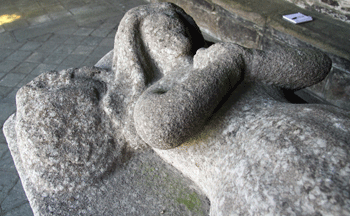
Jeanne de Buchan
Wife of Eon Gillebert Yffiniac Church 15th Century |
|

|
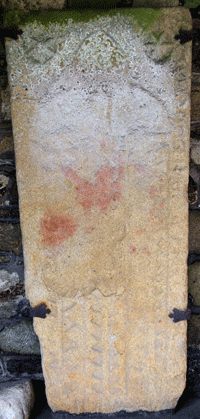
|
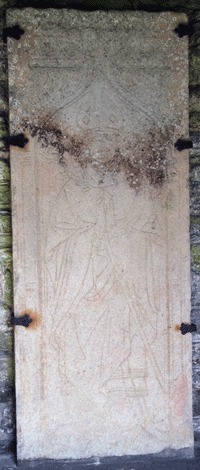
Abbot of Beaulieu (14th C)
|
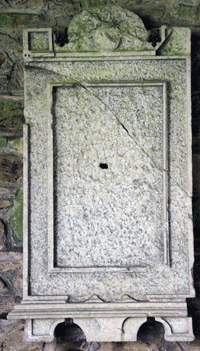
|

|

|

|
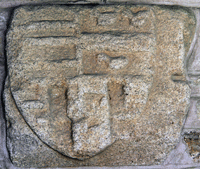
|
|
|
 |
|
| |
| |
| <Top of Page>
<Brittany Index> <Home
- Index -Page> |
| |
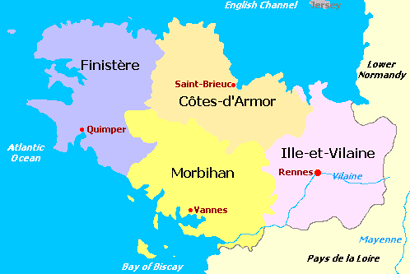

































 Languedoc-Roussillon) on 4th July 1380 after the
English, who had held the town surrendered.Before
his death he had dictated his will stating that he wished to be
buried in his native Brittany, in the Church of the Jacobins at
Dinan, where his ancestors were interred.
Languedoc-Roussillon) on 4th July 1380 after the
English, who had held the town surrendered.Before
his death he had dictated his will stating that he wished to be
buried in his native Brittany, in the Church of the Jacobins at
Dinan, where his ancestors were interred. Constable's body
was beginning to decay despite the embalming. It was therefore
decided to separate the soft tissues (the 'flesh') from the bony
skeleton, so, at the Dominican Convent of Montferrand (a suburb
of the city), the body was boiled in a cauldron to effect this
process. The soft tissues were buried there with a second
funeral service and then the procession continued on its way but
now only carrying the Constable's bones and heart . It is not known
if a monument were constructed over the
site of the burial of the soft tissues at Montferrand as there
appears appears to be no drawing or other record of such a
construction, although it is likely.
Constable's body
was beginning to decay despite the embalming. It was therefore
decided to separate the soft tissues (the 'flesh') from the bony
skeleton, so, at the Dominican Convent of Montferrand (a suburb
of the city), the body was boiled in a cauldron to effect this
process. The soft tissues were buried there with a second
funeral service and then the procession continued on its way but
now only carrying the Constable's bones and heart . It is not known
if a monument were constructed over the
site of the burial of the soft tissues at Montferrand as there
appears appears to be no drawing or other record of such a
construction, although it is likely.
























